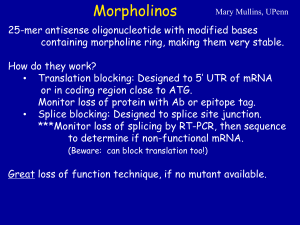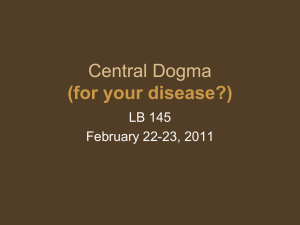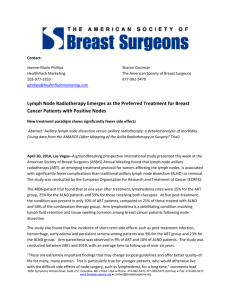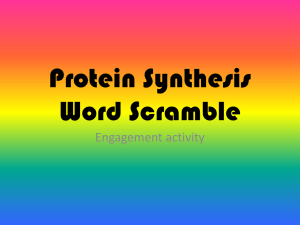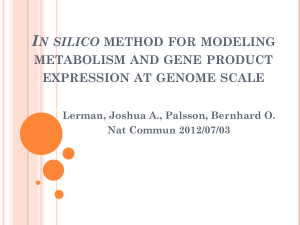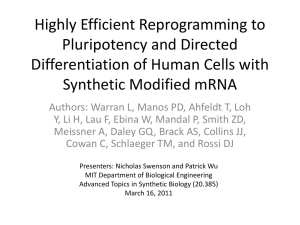ASCO Breast 2012 - IFO Rome
advertisement
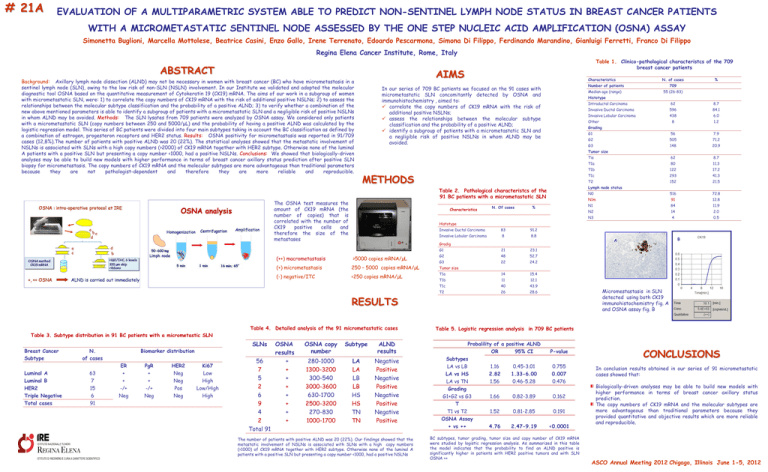
# 21A EVALUATION OF A MULTIPARAMETRIC SYSTEM ABLE TO PREDICT NON-SENTINEL LYMPH NODE STATUS IN BREAST CANCER PATIENTS WITH A MICROMETASTATIC SENTINEL NODE ASSESSED BY THE ONE STEP NUCLEIC ACID AMPLIFICATION (OSNA) ASSAY Simonetta Buglioni, Marcella Mottolese, Beatrice Casini, Enzo Gallo, Irene Terrenato, Edoardo Pescarmona, Simona Di Filippo, Ferdinando Marandino, Gianluigi Ferretti, Franco Di Filippo Regina Elena Cancer Institute, Rome, Italy ABSTRACT Background: Axillary lymph node dissection (ALND) may not be necessary in women with breast cancer (BC) who have micrometastasis in a sentinel lymph node (SLN), owing to the low risk of non-SLN (NSLN) involvement. In our Institute we validated and adopted the molecular diagnostic tool OSNA based on the quantitative measurement of Cytokeratin 19 (CK19) mRNA. The aims of our work in a subgroup of women with micrometastatic SLN, were: 1) to correlate the copy numbers of CK19 mRNA with the risk of additional positive NSLNs; 2) to assess the relationships between the molecular subtype classification and the probability of a positive ALND; 3) to verify whether a combination of the new above mentioned parameters is able to identify a subgroup of patients with a micrometastatic SLN and a negligible risk of positive NSLNs in whom ALND may be avoided. Methods: The SLN lysates from 709 patients were analyzed by OSNA assay. We considered only patients with a micrometastatic SLN (copy numbers between 250 and 5000/μL) and the probability of having a positive ALND was calculated by the logistic regression model. This series of BC patients were divided into four main subtypes taking in account the BC classification as defined by a combination of estrogen, progesteron receptors and HER2 status. Results: OSNA positivity for micrometastasis was reported in 91/709 cases (12,8%).The number of patients with positive ALND was 20 (22%). The statistical analyses showed that the metastatic involvement of NSLNs is associated with SLNs with a high copy numbers (>2000) of CK19 mRNA together with HER2 subtype. Otherwise none of the luminal A patients with a positive SLN but presenting a copy number <1000, had a positive NSLNs. Conclusions: We showed that biologically-driven analyses may be able to build new models with higher performance in terms of breast cancer axillary status prediction after positive SLN biopsy for micrometastasis. The copy numbers of CK19 mRNA and the molecular subtypes are more advantageous than traditional parameters because they are not pathologist-dependent and therefore they are more reliable and reproducible. AIMS Characteristics Luminal A Luminal B HER2 Triple Negative Total cases 63 7 15 6 91 Biomarker distribution ER + + -/+ Neg PgR + + -/+ Neg HER2 Neg Neg Pos Neg Ki67 Low High Low/High High 56 7 5 2 6 9 4 2 Total 91 % 709 55 (26-83) Histotype Intraductal Carcinoma 62 8.7 Invasive Ductal Carcinoma 596 84.1 Invasive Lobular Carcinoma 438 6.0 8 1.2 G1 56 7.9 G2 505 71.2 G3 148 20.9 Tis 62 8.7 T1a 80 11.3 T1b 122 17.2 T1c 293 41.3 T2 152 21.5 516 72.8 N1m 91 12.8 N1 84 11.9 N2 14 2.0 N3 4 0.5 Other Grading Lymph node status N. Of cases N0 % Histotype Invasive Ductal Carcinoma 83 91.2 Invasive Lobular Carcinoma 8 8.8 G1 21 23.1 >5000 copies mRNA/µL G2 48 52.7 G3 22 24.2 (+) micrometastasis 250 – 5000 copies mRNA/µL T1a 14 15.4 <250 copies mRNA/µL T1b 11 12.1 T1c 40 43.9 T2 26 28.6 OSNA copy number Subtype ALND results 280-1000 1300-3200 300-540 3000-3600 630-1700 2500-3200 270-830 1000-1700 LA LA LB LB HS HS TN TN Negative Positive Negative Positive Negative Positive Negative Positive The number of patients with positive ALND was 20 (22%). Our findings showed that the metastatic involvement of NSLNs is associated with SLNs with a high copy numbers (>1000) of CK19 mRNA together with HER2 subtype. Otherwise none of the luminal A patients with a positive SLN but presenting a copy number <1000, had a positive NSLNs B A Gradig Table 3. Subtype distribution in 91 BC patients with a micrometastic SLN N. of cases Median age (range) Table 2. Pathological characteristcs of the 91 BC patients with a micrometastatic SLN Table 4. Detailed analysis of the 91 micrometastatic cases Breast Cancer Subtype Number of patients METHODS (++) macrometastasis OSNA results + + + + + + + + N. of cases Tumor size RESULTS SLNs Characteristics In our series of 709 BC patients we focused on the 91 cases with micrometastatic SLN concomitantly detected by OSNA and immunohistochemistry , aimed to: correlate the copy numbers of CK19 mRNA with the risk of additional positive NSLNs; assess the relationships between the molecular subtype classification and the probability of a positive ALND; identify a subgroup of patients with a micrometastatic SLN and a negligible risk of positive NSLNs in whom ALND may be avoided. The OSNA test measures the amount of CK19 mRNA (the number of copies) that is correlated with the number of CK19 positive cells and therefore the size of the metastases (-) negative/ITC Table 1. Clinico-pathological characteristcs of the 709 breast cancer patients Tumor size Micromestastasis in SLN detected using both CK19 immunohistochemistry fig. A and OSNA assay fig. B Table 5. Logistic regression analysis in 709 BC patients Probalility of a positive ALND OR 95% CI Subtypes LA vs LB LA vs HS LA vs TN Grading G1+G2 vs G3 T T1 vs T2 OSNA Assay + vs ++ P-value 1.16 2.82 1.56 0.45-3.01 1.33-6.00 0.46-5.28 0.755 0.007 0.476 1.66 0.82-3.89 0.162 1.52 0.81-2.85 0.191 4.76 2.47-9.19 <0.0001 BC subtypes, tumor grading, tumor size and copy number of CK19 mRNA were studied by logistic regression analysis. As summarized in this table the model indicates that the probability to find an ALND positive is significantly higher in patients with HER2 positive tumors and with SLN OSNA ++ CONCLUSIONS In conclusion results obtained in our series of 91 micrometastatic cases showed that: Biologically-driven analyses may be able to build new models with higher performance in terms of breast cancer axillary status prediction. The copy numbers of CK19 mRNA and the molecular subtypes are more advantageous than traditional parameters because they provided quantitative and objective results which are more reliable and reproducible. ASCO Annual Meeting 2012 Chigago, Illinois June 1-5, 2012


